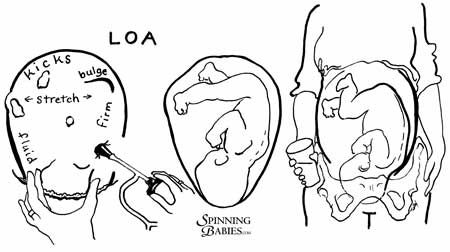
Optimal Foetal Positioning OFP is a theory developed by a midwife Jean Sutton and Pauline Scott an antenatal teacher who found that the mothers position and movement could influence the way her baby lay in the womb in the final weeks of pregnancy. Exercises for Natural Birth.

In this position the back of the baby is slightly off center in the pelvis with the back of the head toward the mothers right thigh.
Optimal fetal positioning. Optimal Fetal Positioning For Birth. To be born a baby rotates and descends through the pelvis. Babys position influences how easy the rotation and descent will be.
Ideally your baby lines up to fit through your pelvis as easily as possible. This is the Left Occiput Anterior position LOA. Exercises for Natural Birth.
When it comes to childbirth our focus goes to areas we may not have thought about before like optimal fetal positioning exercises that can help us ensure proper orientation. When I decided to start a career as a doula in 2014 a big focus in my training was getting the baby in a good position. But what does that really mean and why is.
Different Fetal Positions Occiput This refers to the back of babys head or the nape of babys neck Transverse Sideways or laying horizontally across Left The babys occiput back of their head is facing left Right The babys occiput back of their head is facing right Anterior. You to practice optimal fetal positioning. How to encourage your baby into a good position At around 34 weeks gestation confirm with your midwifedoctor that your baby is coming head first.
Regularly use upright and forward leaning posi-tions. This will allow up to 28 more available pelvic space for your baby to get into the correct position. With more than enough medical evidence and research to show how babies born in the posterior position or have been in a posterior position during labour has led birth workers worldwide to teach Optimal Foetal Positioning OFP - a handbook by New Zealanders Jean Sutton and Pauline Scott to pregnant women where they are taught to understand how the baby moves during labour which.
Be in a forwards leaning position which encourages your baby to move into the right position. When you can sit forwards slightly with your elbows on your knees or sit astride a chair. Sitting on the floor in either a cross legged position or with your legs out will also assist your pelvis to be in the right position.
The best position for a baby to be delivered is a Cephalic position. This is with babys head down and its back facing towards the belly button. It is often referred to as Optimal fetal position OFP Cephalic or Vertex.
If baby is not OFP then it can increase the chances of requiring medical interventions during labour and birth. Optimal Foetal Positioning OFP is a theory developed by a midwife Jean Sutton and Pauline Scott an antenatal teacher who found that the mothers position and movement could influence the way her baby lay in the womb in the final weeks of pregnancy. The left occiput anterior LOA position is the most common in labor.
In this position the babys head is slightly off center in the pelvis with the back of the head toward the mothers left thigh. The right occiput anterior ROA presentation is also common in labor. In this position the back of the baby is slightly off center in the pelvis with the back of the head toward the mothers right thigh.
We are simply asking where is this baby presenting. O Occiput S Sacrum. 3 Where is the back of the babies head presenting in relation to the mothers pelvis.
Front of the Pelvis is Anterior back is posterior sides is transverse. A Anterior PPosterior TTransverse. This circuit is useful to help get the baby lined up ideally in the Left Occiput Anterior LOA Position both before labor begins and when some corrections need to be done during labor.
Prenatally this position set can help to rotate a baby. As a natural method of induction this can help get things going if baby just needed a gentle nudge of position to set things off. The optimal position is occipito-anterior and is the most effective way for a baby to journey through the maternal pelvis In the OA position your baby is head down with his or her face looking at your spine.
In the OP position your baby is head down facing your naval. An OP baby and mother must do more work in order to have a vaginal birth. Labour is often longer and more.
Some experts believe that certain positions can help move your baby from a back-to-back position into an anterior position. This is known as optimal fetal positioning OFP. Unfortunately there isnt much evidence that OFP will help your baby to turn however many.
Pregnancy exercises can help open your pelvis and position your baby in the left occiput anterior or LOA position. This the optimal fetal position for childbirth. Find out if your baby is in the correct fetal positionin this post When to Start Pregnancy Exercises.
Optimal Fetal Positioning- Reduce Labour time Minimise Pain Have A Natural Birth. This pregnancy yoga video is to get baby in the best position for birth whether you want to keep them there or turn a baby for optimal fetal positioning. Optimal Fetal Positioning OFP is a theory developed by a midwife Jean Sutton and Pauline Scott an antenatal teacher who found that the mothers position and movement could influence the way her baby lay in the womb in the final weeks of pregnancy.
Jean Sutton and optimal fetal positioning. Jean Sutton and optimal fetal positioning Mod Midwife. 9052170 No abstract available.
MeSH terms Female Humans Labor Presentation Natural Childbirth methods.